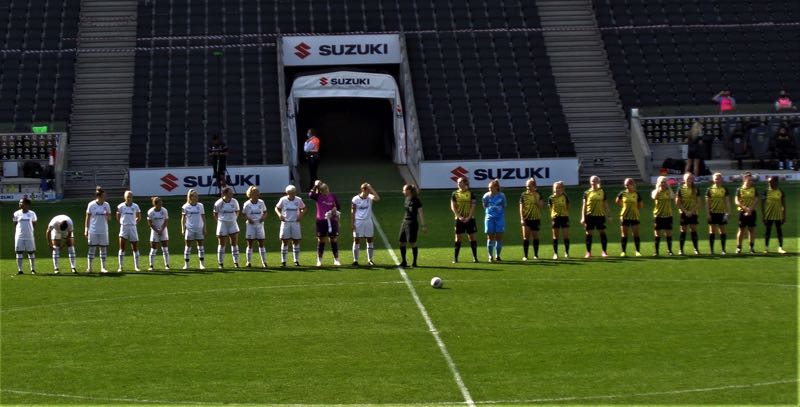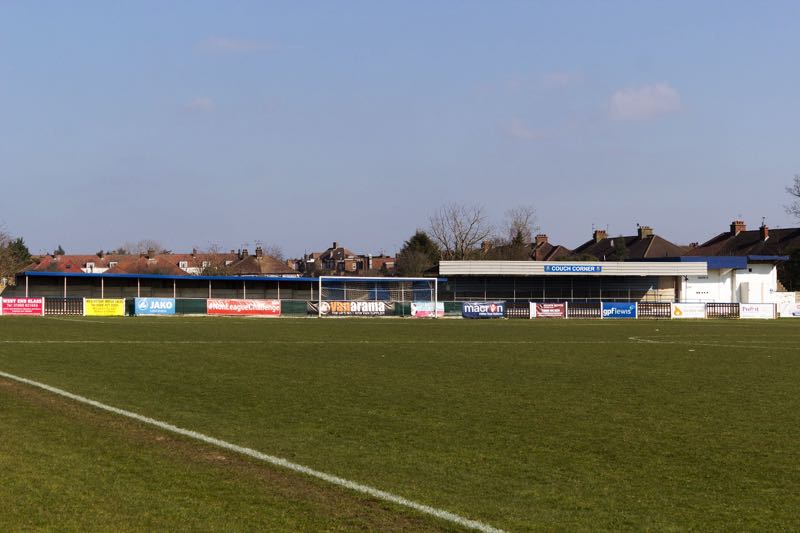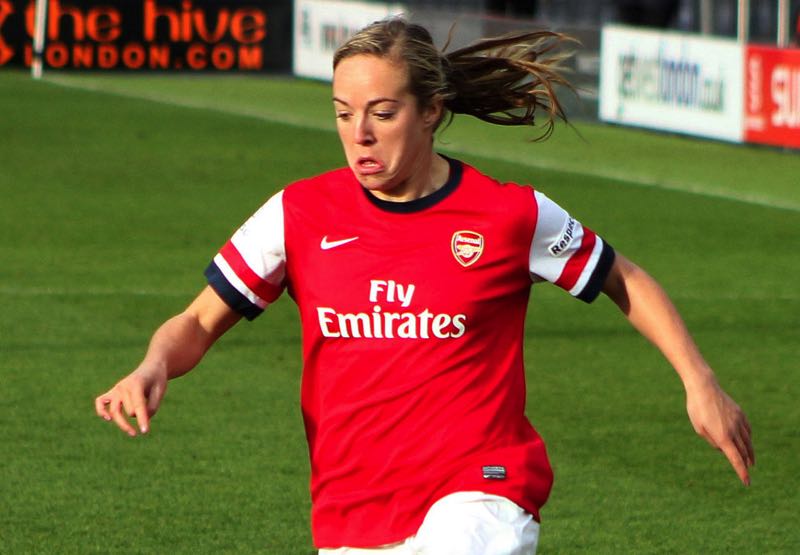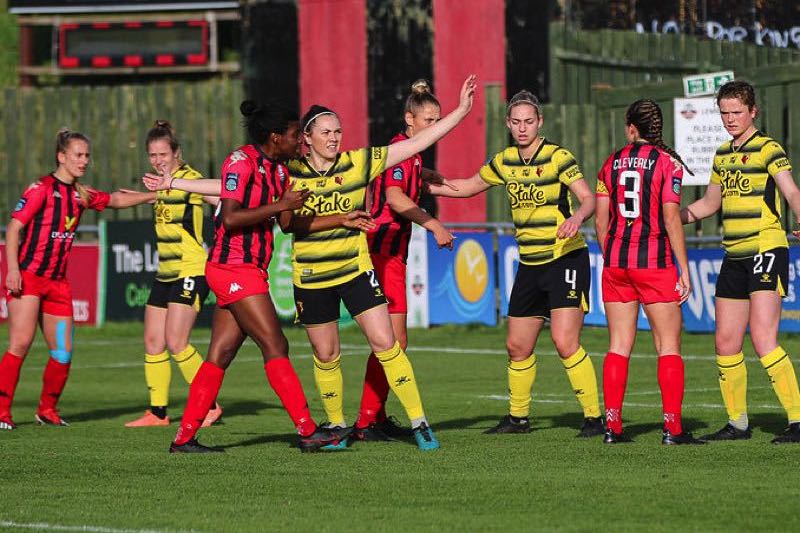As well as being the name of the popular 1980s sitcom, the Golden Girls is also the nickname of Watford FC Women. As with the men’s team, they have quite recently experienced the joy of promotion and the pain of relegation. The similarities do not end there as during the 2023/24 season, both found themselves playing in the second tier of English football.
Despite this comparison to the men’s team here, this piece is a focus on Watford Women. They used to be known as Watford FC Ladies but as an increasing number of teams began dropping the ‘Ladies’ name in favour of ‘Women’, so did Watford. The name change officially came into place in August 2020. In a club statement, Watford said the new name was a “modern view on language and equality and is in keeping with the way our governing bodies, supporters, squad and management regard the women’s game.”
Rather confusingly though, a team by the name Watford Ladies FC still exists. The reason there is both a Watford Ladies team and a separate Watford Women’s side will now be explained.
History of the Watford Women

The history of Watford Women gets a little complicated but stick with us. To cover the whole history we must go back to 1970 when Watford Ladies FC emerged following growing demand at Watford FC (men’s team). For a time the club were known as Willy Walker Watford Wonders due to trainers John Williams and Mike Walker (both former Watford FC players). In 1997, the club merged with Watford Town Girls, which gave youngsters in the area a clearer route of making their way to the senior women’s team.
Having climbed up the leagues, Watford Ladies found themselves in the Southern division of the Women’s Premier League by 2003. Following this, they regained official backing from the men’s club, something that had not been the case since the 1970s. Then, in 2007, the club finished top of the Premier League Southern Division with the reward being a spot in the National Division.
In a slightly hostile move, the Watford Ladies team were told by the new owners taking over Watford FC that they could no longer continue to use the Watford badge. The reason for this was to protect club image rights and it meant the ladies’ team had to develop a new badge for themselves.
When the Women’s Super League (WSL) expanded to create a second tier (WSL 2) in 2014, they welcomed applications to fill the vacant spots. As this was replacing the scrapped Premier League National Division, which Watford were a part of, their application was accepted. Part of a newly formed and more commercially viable league with direct promotion to the Women’s Super League (then known as WS1), these were good times for the women of Watford.
More good news came when their grassroots girls’ teams and elite girls’ teams came under the management of Watford Ladies. At the same time, the WSL 2 senior team moved under the control of Watford FC’s men’s club. Unfortunately though, it became clear that Watford FC were not prepared to pump money into football if it did not relate to the men. They provided no funding for girls’ football and were unwilling to pay the costs associated with obtaining a WSL licence required after the 2017/18 season.
The requirement the FA brought in was that WSL 2 clubs would need to be part-time with some full-time support staff and would need to go full-time if promoted. Three other WSL2 clubs (Oxford United, Sheffield and Doncaster Rovers Belles) also failed to obtain this Tier 2 licence, meaning they could no longer stay in the division. That season the Golden Girls had finished bottom of the table with a mere four points so potentially Watford FC did not view them as a worthwhile investment.
With Watford subsequently dropping down to the amateur Women’s National League (Southern Division), a disgruntled Watford Ladies FC decided to cut ties with Watford FC. Instead, they turned fully independent as they believed their aspirations were not aligned with those shared by the men’s club. So, Watford Ladies FC began playing regional football while the club now known as Watford Women continued to exist in the third tier of English football. Other than sharing the name Watford, the two teams have no other links to one another.
Stadium

Having spoken in-depth about the history of Watford Women, let us focus on the present and where they currently play – Grosvenor Vale. This is the main ground of National League outfit Wealdstone FC, a club made relatively famous by the Wealdstone Raider. The announcement that Watford Women would be moving there in 2022 was no great surprise given that the two clubs have a close relationship. Just days earlier, Wealdstone revealed that the Hornets would be visiting the Vale for a pre-season friendly.
Shirt
As is the situation at most clubs, Watford Women wear the same strip as the men. This means their home outfit is the black and yellow shirt designed by Kelme with the standard Watford crest. Rather than the quite striking design displayed by the home shirt, the away shirt is much plainer, largely white with a bit of claret.
Key Players

Watford may be struggling in the Championship but this does not mean they are without some talented names in their squad.
- Carly Johns – Currently Watford’s main goal threat having made the move from Oxford United in the summer of 2023. The striker was a formidable asset for Oxford, scoring 52 goals in 76 appearances and at the time of writing she had bagged herself five goals and one assist for the Golden Girls. These are decent numbers ordinarily but especially for a team sitting at the bottom of the table.
- Gemma Davison – Although she is heading into her final years of playing, 36-year-old Davison brings a much-needed degree of experience to Watford. The former Arsenal winger has represented England 16 times, a number very few other Championship players can boast. She is perhaps more of an important figure in the dressing room though as it is rare she starts matches these days.
- Michelle Agyemang – Aged just 17, Agyemang is a hugely exciting prospect. She signed a dual-sign agreement with the Golden Girls in 2023 so she is still an Arsenal player and the London club has high hopes for her. A huge threat at English youth level, Watford will be hoping they get to benefit from some of her potential.
Recent Season
Watford Women have become something of a yo-yo club of late, too good for the National League but not good enough for the Championship.
- 2019/20 – Were second with a record of nine wins from 11 matches when the season was curtailed by the global health crisis.
- 2020/21 – No automatic promotion but Watford (top of the table) awarded promotion along with Sunderland.
- 2021/22 – Finished bottom with 11 points from 22 games. Coventry finished just one point better off but only following a 10-point deduction.
- 2022/23 – Ended the season winning the National League South on goal difference, then beat Nottingham Forest in the Championship play-off match.
- 2023/24 – Relegation beckons for the Golden Girls unless there is an unexpected turnaround.

